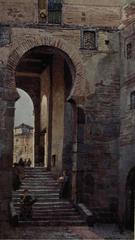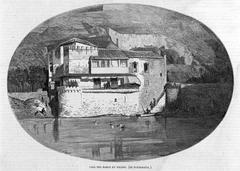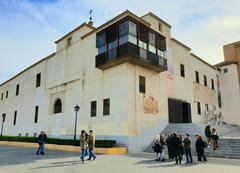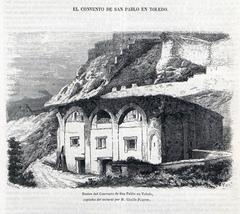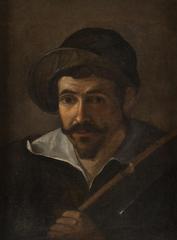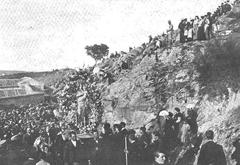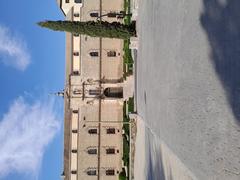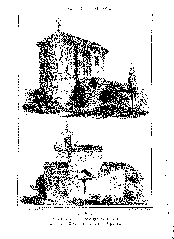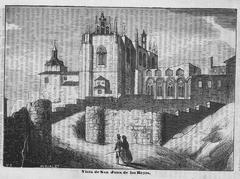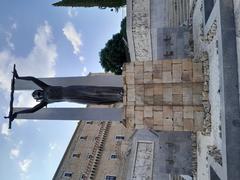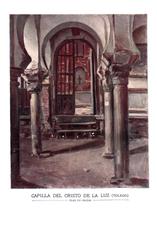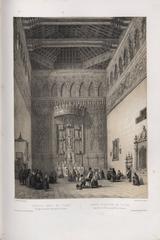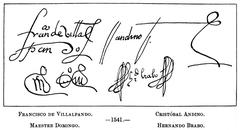
Iglesia de San Bartolomé Toledo: Visiting Hours, Tickets, and Historical Significance
Date: 04/07/2025
Introduction
Located in the heart of Toledo and within the charming municipality of Aldeanueva de San Bartolomé, the Iglesia de San Bartolomé is one of the city’s most compelling historical sites. Renowned for its harmonious blend of late Gothic and Mudéjar architecture, as well as its extraordinary artistic treasures, the church stands as a testament to the region’s multicultural legacy. Whether you are a history enthusiast, an art lover, or a spiritual seeker, a visit to Iglesia de San Bartolomé offers a unique opportunity to experience Toledo’s layered past and vibrant present. This guide will provide you with essential information on visiting hours, tickets, accessibility, historical context, and practical tips for an enriching visit.
Historical Overview
Medieval Origins and Architectural Evolution
The origins of Iglesia de San Bartolomé date to the late 11th or early 12th century, during a period of significant transformation in Toledo following the Christian reconquest. Over time, the church underwent several expansions and modifications, reflecting the changing needs of its community. Notably, its architectural style is a prime example of Mudéjar—a unique synthesis of Islamic decorative motifs and Christian structural elements, emblematic of Toledo’s multicultural heritage (Official Toledo Tourism Website).
The church’s robust exterior is characterized by ashlar masonry and rubblework. The nave, divided by pointed arches, is typical of late Gothic design, while the wooden coffered ceiling (artesonado) represents the enduring influence of Mudéjar artistry. The bell tower, with its triple semicircular openings and decorative granite “medias perlas,” adds both architectural interest and symbolic meaning.
Artistic and Religious Significance
Inside, the church’s most celebrated feature is the fresco cycle by Russian artist Wladimir Strashko. These vivid murals, which depict scenes from the life and martyrdom of Saint Bartholomew, have earned the church the nickname “La Capilla Sixtina de la Jara” (“the Sistine Chapel of the Jara region”) (El Español). The frescoes are notable for their vibrant color palette and dynamic compositions, offering visitors a compelling narrative experience.
The church also houses a baptismal font carved from a single block of sandstone, symbolizing the continuity of Christian tradition in the region. Over the centuries, Iglesia de San Bartolomé has remained the spiritual heart of Aldeanueva de San Bartolomé, hosting religious ceremonies, festivals, and serving as a focal point for community life.
Conservation and Cultural Recognition
Iglesia de San Bartolomé has been declared a Bien de Interés Cultural (Asset of Cultural Interest), ensuring its ongoing preservation. Periodic restorations have maintained both its structural integrity and artistic splendor, while recent archaeological findings have revealed medieval tombs and Visigothic remains, further emphasizing the depth of its historical significance (El Español).
Architectural and Artistic Highlights
- Late Gothic Architecture: The single-nave design, pointed arches, and ribbed vaults evoke the verticality and transcendence of Gothic sacred spaces.
- Mudéjar Ceiling: The ornate coffered ceiling exemplifies the fusion of Islamic and Christian art that defines Mudéjar style.
- Bell Tower: The adjacent tower features three semicircular bell openings and granite “medias perlas,” reflecting both function and symbolism.
- Strashko Frescoes: The interior murals narrate the life of Saint Bartholomew, blending traditional iconography with modern artistry.
- Baptismal Font: A sandstone font carved from a single block, emblematic of the parish’s long-standing religious role.
Cultural and Religious Importance
Dedication and Festivals
The church is dedicated to Saint Bartholomew, one of the apostles, whose feast day on August 24th is a highlight of the local calendar. The annual festival blends religious devotion with vibrant local traditions, drawing both parishioners and visitors.
Community and Pilgrimage
As the active parish church of Aldeanueva de San Bartolomé, the Iglesia continues to serve as the venue for baptisms, weddings, funerals, and community gatherings. Its artistic treasures attract art historians and pilgrims alike, while guided tours and educational programs foster broader appreciation of its heritage (El Español).
Visiting Information
Location and Access
- Address: Aldeanueva de San Bartolomé, Toledo province, Castilla-La Mancha, Spain.
- Directions: Approximately 120 km southwest of Toledo city, accessible via the CM-4100 road. Public transport is limited; car travel is recommended.
Visiting Hours and Admission
- General Hours: Daily, 10:00 AM – 6:00 PM. Extended hours during festivals.
- Mass Times: Vary seasonally (evening in summer, earlier in winter). Check misas.net or local parish announcements for updates.
- Admission: Free. Donations are encouraged to support preservation.
- Guided Tours: Available by appointment, especially for groups and during festivals.
Accessibility
- Wheelchair Access: Main entrance has ramps; some interior areas may have limited accessibility due to historic structure. Contact the parish in advance for assistance.
Visitor Etiquette
- Dress modestly, maintain silence, and respect restrictions during religious services.
- Photography without flash is generally allowed outside of Mass or private events.
Tips for Your Visit
- Check current visiting hours and Mass schedules before arrival.
- Combine your visit with other nearby sites: Toledo Cathedral, Monastery of San Juan de los Reyes, Iglesia de Santo Tomé, and the natural park of La Jara.
- Attend local festivals for a unique cultural experience.
Frequently Asked Questions (FAQ)
Q: What are the Iglesia de San Bartolomé visiting hours?
A: Daily from 10:00 AM to 6:00 PM; hours may be extended during festivals. Always confirm with the parish or misas.net.
Q: Is there an admission fee or tickets required?
A: Admission is free; donations are appreciated.
Q: Are guided tours available?
A: Yes—especially during festivals or for groups, by prior arrangement.
Q: Is the church wheelchair accessible?
A: The main entrance is ramped, but some interior sections may present challenges. Contact the parish in advance for information.
Q: How do I get to the church from Toledo?
A: By car via the CM-4100 road. Public transportation is limited.
Visual Gallery
Summary and Further Exploration
The Iglesia de San Bartolomé in Toledo is a vibrant example of Spain’s intertwined Christian and Islamic histories, renowned for its Mudéjar ceiling, late Gothic architecture, and the remarkable Strashko frescoes. As both a protected heritage site and a living parish, it offers visitors an immersive journey through centuries of art, faith, and community tradition.
To ensure a rewarding visit, plan ahead by checking current hours and events, consider joining a guided tour, and support ongoing conservation by making a donation. Enhance your trip by exploring nearby Toledo historical landmarks and enjoying the local culture.
For more information, consult the official sources and related articles below.
Useful Links and Further Reading
- Official Toledo Tourism Website
- Guided Tours Booking - Toledo Tourist Office
- Iglesia de San Bartolomé on UNESCO World Heritage site
- El Español – “Capilla Sixtina de la Jara”
- El Español – Capilla Sixtina de Toledo
- Misas.net – Mass Times and Parish Info


